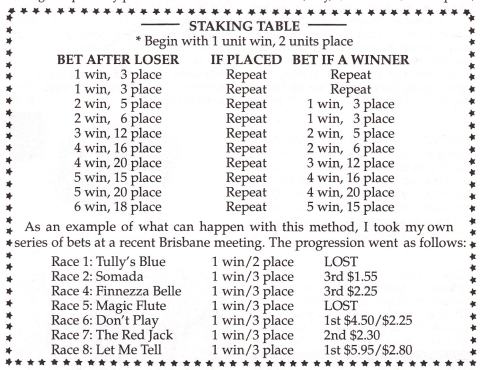Insurance! No, this is not an article about how to keep the door-to-door insurance man at bay. It's about betting insurance.
If you are one of those punters legions of them-who refuse to have anything to do with 'playing safe' in your betting then this idea is one you should closely examine. It's a simple formula of attack that allows the place-bet part of your investment act as your insurance against total loss.
I came across the plan many years ago and often have recommended it to punter friends who complained they had been burned once too often by not taking out a 'safe insurance' on their bets. They'd been going in madly for the win and not thinking about all the 2nds and 3rds they were backing, and thinking even less about how to capitalise to some extent on those placegetters.
This plan - I call it The Both Totes Terror - is worth considering. After all, there's not a punter in the land who prefers to lose rather than at least save his stake when a horse fails to reach the line in first place.
Your opening investment is one unit to win (a unit can be any amount of money you like, but we'll talk in $1 unit terms for the purposes of this article) and two units for a place. If the horse you have backed wins then you drop back as indicated in the accompanying table of stakes. Should the horse run unplaced (mongrel!) then you progress as the table indicates.
The table shows you simply how the staking plan operates. Follow it exactly as it says and you can't go wrong. Now this method will NOT win you a fortune but it can be a very steady winner for you as long as your race selections are sane and rational. It is especially recommended for selections in races which have between eight and 10 runners.
My personal recommendation is that you run twin betting banks-one for all selections, and the second for bets in those races with between eight and 10 runners. I predict that your second bank will provide the most profit on turnover!
In the table of staking I have shown the ratio of bets for 10 races. Now this should be ample to cover this form of betting.
Punters who have used the method-and still use it successfully--say that you should always start a new series of bets once you are making a nett profit. That's a nice, safe idea but those of you with daring will probably prefer to soldier on.
As you can see, the progression never got past the 1 win/3 place mark, due to the performance of the selections. There was a loss of three units on Tully's Blue, then a return of $4.65 on Somada. The bet on Finnezza Belle returned $6.75. There was a loss of four units on Magic Flute. The bet on Don't Play returned $11.25. The Red Jack gave a return of $6.90, while Let Me Tell returned $14.35.
The total outlay for the day was $27 and the return was $43.90, a profit on turnover of 62 per cent. This is excellent. On three occasions, the place bet acted as insurance for the failure of the win portion of the stake.
Let's assume you backed four losers in a row. This would mean you outlaid 1/2, then 1/3, another 1/3 and then 2/5, a total of 18 units. Your next bet would be two units a win and six units place. If you happened to strike a placegetter at, say, even money then your return would be $12, for a profit of $4 on that bet, leaving you $14 in arrears. Your next horse will have the same amount of money on it. If it won at, say, $3.00 and $1.90 a place, your return would be $17.40, for a profit on that bet of $9.40. You would now be only $4.60 in arrears and yet you have backed only one winner at 2-1 and a placegetter at evens PLUS four losers!
You cannot, then, get into deep trouble if you adopt this clever, but very simple, staking plan. You are putting on more for a place than a win, and that course of action is providing you with 'insurance' on your money.
I heartily recommend it for punters who like to stick to straight-out betting and who ignore the exotic bets like quinellas, trifectas etc.
My suggestion is that you photocopy the Staking Table and tuck it into your coat pocket when you go to the races. Refer to it as each bet is made.
Remember this - play safe, and money stays safely in your pocket. Much better to be in your pocket than in the bookmaker's pocket, which it probably would be if you had not played for insurance.

By Jon Hudson
PRACTICAL PUNTING - AUGUST 1987